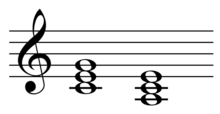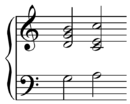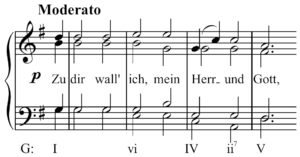Submediant
In music, the submediant is the sixth scale degree of the diatonic scale, the 'lower mediant', halfway between the tonic and the subdominant or 'lower dominant'.[1][2] It is also the third factor of the subdominant (IV) triad. It is occasionally called superdominant,[3] as the degree above the dominant (see also below, "Theory"). It is sung la in solfege. In music theory, the submediant chord is symbolized by the Roman numeral VI if it is major or vi if it is minor.[4]
Usage


In the C major scale (white keys on a piano, starting on C), the submediant is the note A; and the submediant chord is A-minor, consisting of the notes A, C, and E. Therefore, Am is the vi chord in the C major scale. The scales of C major and A (natural) minor have the property of sharing the same notes: they are said to be the relative of each other, and the C major and A minor chords are also said the relative of each other. In the A natural minor scale (same white keys, now starting on A), the submediant is the note F; and the submediant chord is F-major, consisting of the notes F, A, and C. Therefore, F is the VI chord in the A (natural) minor scale. These chords (and the corresponding keys) cannot be said to be relative of each other, however, because their scale is not the same: the F major scale includes a B♭ which is absent in the A minor scale.
Since the submediant chord is minor in a major key, and major in a minor key, it provides contrast with its tonic chord. Similarly, submediant and tonic keys contrast with each other even although they may make use of the same scale.
One of the main usages of the submediant chord is in the deceptive cadence, V7–vi in major or V7–VI in minor.[6][7]
In major, the submediant chord also often appears as the starting point of a series of perfect descending fifths and ascending fourths leading to the dominant, I | vi-ii-V-I. This is because the relationship between vi and ii and between ii and V potentially is the same as that between V and I. If all chords were major (I-VI-II-V-I), the succession would be one of secondary dominants[8] (See also predominant chord and vi ii V I.) This submediant role is as common in popular and classical music as it is in jazz, or any other musical language related to Western European tonality. A more complete version starts the series of fifths on the chord of iii, I-iii-vi-ii-V-I, as in Charlie Parker's Blues for Alice. In minor, the progression from VI to ii° (e.g. A♭–D in C minor) involves a diminished fifth, as does the ii° chord itself; it may nevertheless be used in VI-ii°-V-I by analogy with the major. Similarly, the full circle progression I-IV-vii°-iii-vi-ii-V-I can be used by analogy with the usual descending fifth progression, even although IV-vii° involves a diminished fifth.
Another frequent progression is the sequence of descending thirds (I-vi-IV-ii | V in root position or first inversion), alternating major and minor chords.[8] This progression is also frequent in jazz music, where it is used in a shortened version (I-vi-IV-V) in the "ice cream change", which moves from the tonic through the submediant and subdominant on the way to the dominant.
As to the relationship between musical keys, the modulation (change of key) to the submediant is relatively rare, compared with, for instance, modulation to the dominant or, in minor, to the mediant (the major relative). Susan McClary says that modulation to the lowered submediant (in C: A♭) represents a dream-like state of escape.

In rock and popular music, VI in minor often uses the chromatically lowered fifth scale degree as its seventh, VI7, for example as in Bob Marley's clearly minor mode "I Shot The Sheriff".[9]
Chromatic submediants are, like all chromatic mediants, chords whose roots are related by a major third or minor third, contain one (common tone), and share the same quality, i.e. major or minor. They may be altered chords.
Theory
The term "mediant" appeared in English in 1753 to refer to the note "midway between the tonic and the dominant".[10] The term "submediant" must have appeared soon after to similarly denote the midpoint between the tonic and the subdominant.[11] The German word Untermediante is found in 1771.[12] In France, on the other hand, the sixth degree of the scale was more often called the sus-dominante, as the degree above the dominant. This reflects a different conception of the diatonic scale and its degrees:[13]
- A unified conception in Germanic languages (including English), where the tonic is flanked on both sides by subtonic / supertonic, submediant / mediant and subdominant / dominant;
- A dual conception in French and Italian, with subtonic (sous-tonique, sotto-tonica) / supertonic (sustonique, sopra-tonica) on both sides of the tonic, subdominant (sous-dominante, sotto-dominante) / "superdominant" (sus-dominante, sopra-dominante) on both sides of the dominant – and the mediant left alone between the two.
In German theory derived from Hugo Riemann the submediant in major is considered the Tonikaparallele (tonic relative, tonic parallel), Tp, and the minor the Subdominantparallele (subdominant relative, subdominant parallel), sP.
See also
Sources
- ↑ Benward & Saker (2003). Music: In Theory and Practice, Vol. I, p.33. Seventh Edition. ISBN 978-0-07-294262-0. "The lower mediant halfway between tonic and lower dominant (subdominant)."
- ↑ Forte, Allen (1979). Tonal Harmony, p.120. 3rd edition. Holt, Rinehart, and Wilson. ISBN 0-03-020756-8. "The triad on VI is called the submediant because it occupies a position below the tonic triad analogous to that occupied by the mediant above the tonic triad.
- ↑ Ebenezer PROUT, Harmony: its theory and practice, 09/09/2010
- ↑ Bartlette, Christopher, and Steven G. Laitz (2010). Graduate Review of Tonal Theory. New York: Oxford University Press, pg 102-106. ISBN 978-0-19-537698-2
- ↑ Chadwick, G.H. (2009). Harmony - A Course Of Study, p.36. ISBN 1-4446-4428-9.
- ↑ Foote, Arthur (2007). Modern Harmony in its Theory and Practice, p. 93. ISBN 1-4067-3814-X.
- ↑ Owen, Harold (2000). Music Theory Resource Book, p.132. ISBN 0-19-511539-2.
- 1 2 3 4 William G Andrews and Molly Sclater (2000). Materials of Western Music Part 1, p.226. ISBN 1-55122-034-2.
- ↑ Stephenson, Ken (2002). What to Listen for in Rock: A Stylistic Analysis, p.89. ISBN 978-0-300-09239-4.
- ↑ Etymology Dictionary, s.v. "Mediant".
- ↑ The term can be found in John W. Calcott, A Musical Grammar in Four Parts, London, 3d edition, 1817, p. 137. (1st edition 1806.)
- ↑ Johann Georg Sulzer, Allgemeine Theorie der Schönen Künste, 1771, s.v. "Sexte".
- ↑ See Nicolas Meeùs, "Scale, polifomia, armonia", in J. J. Nattiez (ed), Enciclopedia della musica, vol. II, Il sapere musicale, Torino, Einaudi, 2002, p. 84.


